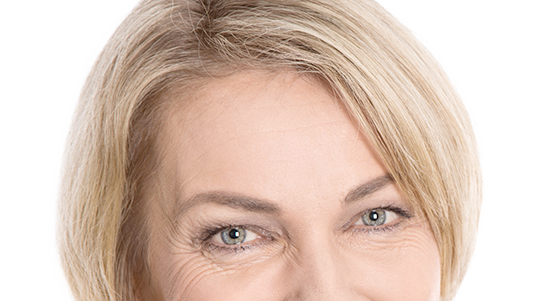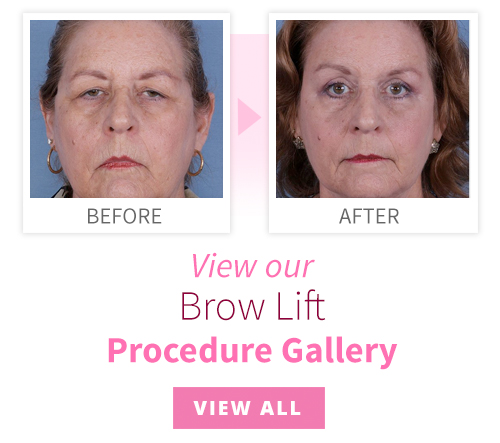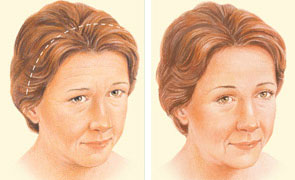The forehead and brow are amongst the most expressive parts of the face. The position of your brow can signify happiness or stress. Unfortunately as we age, we get wrinkles in the forehead as well as in the lower brow area making us look tired and sometimes angry. Because of this, fixing the forehead and brow area can be amongst the most rewarding parts of the face to address, as it can greatly “freshen up” the face. With many newer endoscopic techniques, this can often be accomplished with minimal incisions and very little down time. Make sure you discuss options to address this very important part of your face with your plastic surgeon.
Questions & Answers
What is a brow lift?
A brow lift, also known as a forehead lift:
- Reduces the wrinkle lines that develop horizontally across the forehead, as well as those that occur on the bridge of the nose, between the eyes
- Improves frown lines, the vertical creases that develop between the eyebrows
- Raises sagging brows that are hooding the upper eyelids
- Places the eyebrows in an alert and youthful position
Other cosmetic procedures that may be performed with a brow lift include:
- Upper and or lower eyelid tucks
- Facelifting
- Skin resurfacing techniques
How much will brow lift surgery cost?
Your cost will be based on your individual plan and procedure.
Call us at (352) 629-8154 to set up a FREE Consultation.
We offer patient financing plans, so be sure to ask.
Brow lift surgery costs may include:
- Anesthesia fees
- Hospital or surgical facility costs
- Medical tests
- Post-surgery garments
- Prescriptions for medication
- Surgeon’s fee
When choosing a board-certified plastic surgeon for a brow lift, remember that the surgeon’s experience and your comfort with him or her are just as important as the final cost of the surgery.
Brow lift candidates
You may be a candidate for brow lift surgery if you:
- Are physically healthy
- Don’t smoke
- Have a positive outlook and realistic goals
As we age, unsightly wrinkle lines may appear on the forehead. Frown lines between the brows can make us look angry or “too serious.” Skin relaxation may cause the eyebrows to drop, hooding our upper eyelids and making us look tired. If you are bothered by these signs of aging in the brow region, a brow lift may be right for you.
Brow lift recovery
During your brow lift recovery, your forehead may be taped and your head may be loosely wrapped to minimize swelling and bruising after the procedure is completed.
A thin tube may be present to drain any excess blood or fluid that may collect under the skin.
You will be given specific instructions that may include:
- How to care for the surgical site and drains
- Medications to apply or take orally to aid healing and reduce the potential for infection
- Specific concerns to look for at the surgical site or in your general health
- When to follow up with your plastic surgeon.
You should keep your head elevated and perform no vigorous physical activity for as long as your surgeon recommends. Do not use ice or heat on the operated area.
Be sure to ask your plastic surgeon specific questions about what you can expect during your individual recovery period.
- What medication will I need after surgery?
- Will I have dressings/bandages?
- When will they be removed?
- Are stitches removed? When?
- When can I resume normal activity and exercise?
- When do I return for follow-up care?
Brow lift surgery recovery time
Initial wound healing may take 10 to 14 days. Sutures or clips will be removed when it is appropriate. You should be ready to return to work and normal activity after two weeks.
Cosmetics can help camouflage any bruising.
Even though you will look presentable to the public, you will find that the healing will continue for several weeks, as the swelling dissipates and incision lines refine and fade. It may take several months for your complete recovery.
Following your physician’s instructions is essential to the success of your surgery.
It’s important that the surgical incisions are not subjected to excessive force, swelling, abrasion, or motion during the time of healing. Your doctor will give you specific instructions on how to care for yourself.
Brow lift before and after results
The results of your brow lift surgery are immediately visible. Over time, post-surgical swelling will resolve and incision lines will fade.
Satisfaction with your new image should continue to grow as you recover from surgery. The final results of your surgery will appear over the next few months.
Brow lift before & after results photo gallery
Although good results are expected from your procedure, there is no guarantee. Life-long sun protection will help to maintain your rejuvenated appearance by minimizing sun damage. A healthy lifestyle will also help extend the results of your rejuvenated, more youthful appearance.
Brow lift procedural steps
Step 1 – Anesthesia
You will be given medication so that you will be comfortable during the surgical procedures. Your surgeon will suggest either intravenous sedation or general anesthesia.
Step 2 – The incision
Brow lifts can be performed in different ways. Some surgeons prefer using an endoscope (a thin tube with a camera on the end) and special instruments placed through small incisions made within the hairline. This allows the tissue and muscle beneath the skin to be adjusted, correcting the source of visible creases and furrows in the forehead.
Endoscopic incision
Some surgeons prefer to perform a browlift through what is called a “coronal incision” The coronal incision is created from ear to ear across the top of the head, within the hair-bearing skin.
The forehead skin is then lifted and any muscle adjustment can be made under direct visualization. The resulting scar from a coronal brow lift is well concealed within the hair.
Coronal incision
For women with very high foreheads, an incision just at the anterior hairline may be recommended. In this way the brow can be lifted without altering the height of the front hairline. The resulting scar, while somewhat more visible, can often be hidden with bangs.
Step 3 – Closing the incisions
Brow lift incisions typically are closed with:
- Removable or absorbable sutures
- Skin adhesives
- Surgical tape
- Special clips
Step 4 – See the results
Results appear gradually as swelling and bruising subside to reveal smoother forehead skin and a more youthful, rested appearance. Get more information about brow lift results. (see tab titled “Brow lift before and after results”)
Brow lift risks and safety information
The decision to have plastic surgery is extremely personal. You will have to decide if the surgery will achieve your goals and if the risks and potential complications of a brow lift are acceptable.
You will be asked to sign consent forms to ensure that you fully understand the procedure and any risks and potential complications.
Brow lift surgery risks include:
- Anesthesia risks
- Bleeding
- Loss of hair around the incisions
- Elevated hairline
- Eye irritation or dryness
- Facial asymmetry
- Facial nerve injury with weakness or paralysis
- Fluid accumulation
- Infection
- Numbness or other changes in skin sensation or intense itching
- Pain, which may persist
- Poor wound healing
- Possibility of revision surgery
- Skin discoloration and swelling
- Skin loss
- Unfavorable scarring
- Rare risk of blood clots
These risks and others will be fully discussed prior to your consent. It’s important that you address all your questions directly with your plastic surgeon.
Your brow lift consultation
During your brow lift consultation be prepared to discuss:
- Your goals for your appearance
- Your complete medical history
- Your current medications, vitamins, herbal supplements, alcohol, tobacco, and drug use
Your brow lift surgeon will also:
- Evaluate your general health status and any risk factors
- Discuss your options
- Examine and measure different parts of your face
- Take photographs
- Recommend a course of treatment
- Discuss likely outcomes of brow lift surgery and any potential complications
Be sure to ask questions. To help, we have prepared a checklist of questions to ask your brow lift surgeon that you can take with you to your consultation.
It’s very important to understand all aspects of your brow lift procedure. It’s natural to feel some anxiety, whether it’s excitement for your anticipated new look or a bit of preoperative stress. Don’t be shy about discussing these feelings with your plastic surgeon.
Preparing for brow lift surgery
In preparing for brow lift surgery, you may be asked to:
- Get lab testing or a medical evaluation
- Take certain medications or adjust your current medications
- Stop smoking
- Avoid taking aspirin, anti-inflammatory drugs, and other supplements as they can increase bleeding
Brow lift surgery should be performed in an accredited surgical facility, licensed ambulatory surgical center, or a hospital.
You will need to arrange for another adult to drive you to and from surgery, and to stay with you for at least the first night following surgery.
Brow lift words to know
- Brow lift: A surgical procedure to correct a low-positioned or sagging brow. Smooths furrows across the forehead and between the brows.
- Endoscope: A surgical video device sometimes used during brow lift procedures.
- General anesthesia: Drugs and/or gases used during an operation to relieve pain and alter consciousness.
- Hematoma: Blood pooling beneath the skin.
- Intravenous sedation: Sedatives administered by injection into a vein to help you relax.
- Local anesthesia: A drug injected directly to the site of an incision during an operation to relieve pain.
- Skin resurfacing: Treatment to improve the texture, clarity and overall appearance of your skin.
- Sutures: Stitches used by surgeons to hold skin and tissue together.
Questions to ask my plastic surgeon
Use this checklist as a guide during your brow lift consultation:
- Are you certified by the American Board of Plastic Surgery?
- Were you specifically trained in the field of plastic surgery?
- How many years of plastic surgery training have you had?
- Do you have hospital privileges to perform this procedure? If so, at which hospitals?
- Is the office-based surgical facility accredited by a nationally- or state-recognized accrediting agency, or is it state-licensed or Medicare-certified?
- Am I a good candidate for this procedure?
- What will be expected of me to get the best results?
- Where and how will you perform my procedure?
- What surgical technique is recommended for me?
- How long of a recovery period can I expect, and what kind of help will I need during my recovery?
- What are the risks and complications associated with my procedure?
- How are complications handled?
- How can I expect to look over time?
- What are my options if I am dissatisfied with the cosmetic
outcome of my brow lift surgery? - Do you have before-and-after photos I can look at for this procedure and what results are reasonable for me?
Choose a surgeon you can trust
Brow lift surgery involves many choices. The first and most important is selecting a member of the American Society of Plastic Surgeons (ASPS) surgeon you can trust.
- ASPS member surgeons meet rigorous standards:
- Board certification by the American Board of Plastic Surgery® (ABPS) or in Canada by The Royal College of Physicians and Surgeons of Canada®
- Complete at least six years of surgical training following medical school with a minimum of three years of plastic surgery residency training
- Pass comprehensive oral and written exams
- Graduate from an accredited medical school
- Complete continuing medical education, including patient safety, each year
- Perform surgery in accredited, state-licensed, or Medicare-certified surgical facilities
Do not be confused by other official sounding boards and certifications.
The ABPS is recognized by the American Board of Medical Specialties (ABMS), which has approved medical specialty boards since 1934. There is no ABMS recognized certifying board with “cosmetic surgery” in its name.
By choosing a member of the American Society of Plastic Surgeons, you can be assured that you are choosing a qualified, highly trained plastic surgeon who is board-certified by the ABPS or The Royal College of Physicians and Surgeons of Canada.
Q&A Content Copyright © American Society of Plastic Surgeons

















